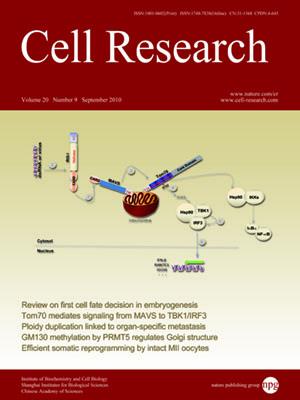
Volume 20, No 9, Sep 2010
ISSN: 1001-0602
EISSN: 1748-7838 2018
impact factor 17.848*
(Clarivate Analytics, 2019)
Volume 20 Issue 9, September 2010: 982-993
REVIEWS
Molecular basis of the first cell fate determination in mouse embryogenesis
Lingyi Chen1, Dekun Wang1, Zhaoting Wu1, Liping Ma1 and George Q Daley2,3,4,5,6
1Ministry of Education Key Laboratory of Bioactive Materials, College of Life Sciences, Nankai University, 94 Weijin Road, Tianjin 300071, China
2Division of Pediatric Hematology/Oncology, Children's Hospital Boston and Dana Farber Cancer Institute, 300 Longwood Avenue, Boston, MA 02115, USA
3Department of Biological Chemistry and Molecular Pharmacology, Harvard Medical School, Boston, MA, USA
4Division of Hematology, Brigham and Women's Hospital, Boston, MA, USA
5Harvard Stem Cell Institute, Boston, MA, USA
6Howard Hughes Medical Institute, Boston, MA, USA
Correspondence: Lingyi Chen, George Q Daley,(lingyichen@nankai.edu.cn; george.daley@childrens.harvard.edu)
Through proliferation and differentiation, a single cell, the zygote, can give rise to a complex organism composed of many types of cells. Up to the eight-cell embryo stage, the blastomeres are morphologically identical and distributed symmetrically in the mammalian embryo. Functionally, in some species, they are all totipotent. However, due to the compaction of blastomeres and the asymmetrical cell division at the late phase of the eight-cell embryo, the blastomeres of the morula are no longer identical. During the transition from morula to blastocyst, blastomeres differentiate, resulting in the first cell fate decision in embryogenesis, namely, the segregation of the inner cell mass and the trophectoderm. In this review, we will discuss the regulatory mechanisms essential for the cell fate choice during blastocyst development, including transcriptional regulation, epigenetic regulation, microRNAs, and signal transduction.
Cell Research (2010) 20:982-993. doi: 10.1038/cr.2010.106; published online 13 July 2010
FULL TEXT | PDF
Browse 2258


